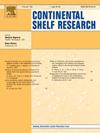Understanding heavy Metal pollution dynamics in Çandarlı Gulf, western Türkiye: Insights from spatial analysis, sediment transport modeling and ecological risk assessment
IF 2.2
3区 地球科学
Q2 OCEANOGRAPHY
引用次数: 0
Abstract
This study investigates the sources, levels, and distribution of heavy metals in the surficial sediments of the Çandarlı Gulf, examining both natural and anthropogenic influences. Using sediment transport models, pollution assessments, and principal component analysis (PCA), have been identified mean metal concentrations in sediments as Zn > Cr > Pb > Ni > Cu > As. PCA revealed five key sources: natural processes, biogenic impacts, anthropogenic activities, industrial runoff, and wastewater. The sediment characteristics vary regionally, with high-energy conditions and sand dominance in the south, and finer materials in the north. High carbonate content in sandy areas links to mechanical abrasion. Trace elements like As, Cr, Cu, Pb and Zn exceed background values in southern and northeastern zones due to activities like container handling and ship dismantling. Ecological risk assessments show frequent adverse effects for Ni and As, and occasional effects for Cu and Zn. The study emphasizes the need for comprehensive pollution control strategies to protect the Çandarlı Gulf's marine ecosystem.

了解Çandarlı海湾地区重金属污染动态:来自空间分析、泥沙运移模型和生态风险评估的见解
本研究调查了Çandarlı海湾表层沉积物中重金属的来源、水平和分布,考察了自然和人为影响。利用沉积物输运模型、污染评估和主成分分析(PCA),确定了沉积物中平均金属浓度为Zn和gt;Cr祝辞Pb祝辞倪祝辞铜比;作为。PCA揭示了5个主要来源:自然过程、生物影响、人为活动、工业径流和废水。沉积物特征区域性差异较大,南部以高能条件和沙质为主,北部以细粒物质为主。沙质地区碳酸盐含量高与机械磨损有关。由于集装箱装卸和拆船等活动,南部和东北部地区的As、Cr、Cu、Pb和Zn等微量元素超过了背景值。生态风险评价显示,Ni和As的不良影响较为频繁,Cu和Zn的不良影响较为偶然。该研究强调需要全面的污染控制策略来保护Çandarlı海湾的海洋生态系统。
本文章由计算机程序翻译,如有差异,请以英文原文为准。
求助全文
约1分钟内获得全文
求助全文
来源期刊

Continental Shelf Research
地学-海洋学
CiteScore
4.30
自引率
4.30%
发文量
136
审稿时长
6.1 months
期刊介绍:
Continental Shelf Research publishes articles dealing with the biological, chemical, geological and physical oceanography of the shallow marine environment, from coastal and estuarine waters out to the shelf break. The continental shelf is a critical environment within the land-ocean continuum, and many processes, functions and problems in the continental shelf are driven by terrestrial inputs transported through the rivers and estuaries to the coastal and continental shelf areas. Manuscripts that deal with these topics must make a clear link to the continental shelf. Examples of research areas include:
Physical sedimentology and geomorphology
Geochemistry of the coastal ocean (inorganic and organic)
Marine environment and anthropogenic effects
Interaction of physical dynamics with natural and manmade shoreline features
Benthic, phytoplankton and zooplankton ecology
Coastal water and sediment quality, and ecosystem health
Benthic-pelagic coupling (physical and biogeochemical)
Interactions between physical dynamics (waves, currents, mixing, etc.) and biogeochemical cycles
Estuarine, coastal and shelf sea modelling and process studies.
 求助内容:
求助内容: 应助结果提醒方式:
应助结果提醒方式:


